‘Almost every fifth pair of shoes in the world is made in Agra.’
—A local shoemaker, Agra
Any mention of the city of Agra conjures up the image of the Taj Mahal every time. However, Agra has more to it than just this World Heritage Site, the shoemaking industry being one other feather on its cap.
The history of the shoemakers of Agra is indeed an interesting one. After the establishment of Mughal rule in India in 1526, Agra was one of the important centres of trade and commerce, just like Delhi, Srinagar and Lahore. Given their fondness for food and a long heritage of cuisines, it was no surprise that the Mughals sourced ingredients from far-off places, for instance, 'hing' (Asafoetida) was imported from Afghanistan and Iran, packed in leather containers called mushak. These mushaks were discarded once their purpose was served. The craftsmen of Agra soon realized that these leather bags could be reused for making footwear. Thus began the footwear industry in Agra. Even today, one of the main markets for footwear in the city goes by the name 'Hing Ki Mandi', with over 5000 shops.
Shoemaking was prosperous industry under the Mughals and continued to thrive during the British period. While initially the shoemakers worked exclusively to produce embroidered footwear in velvet and silk cloth studded with golden threads, sold under the name 'Salem Shahis', later they also started making footwear for the British army. Under the British, there was also increased demands of other items such as bags, belts, buttons and suitcases.
Unfortunately, during the Indian independence struggle and Partition, the production suffered, and many establishments shut shop, as many Muslim craftsmen who largely controlled the industry moved out of the country.
Over time, however, with initiatives by government and private companies and footwear expos both in India and abroad, the industry could bounce back to an extent. Today, the collection of shoes found in the market is varied and vast, be it canvas shoes, sneakers or leather sandals, sports shoes or cotton mochasins. The boots worn by famous mountaineer Bichendri Pal for her expedition to Mt Everest were also made in Agra. Some of the major footwear markets still in business are Nai Ki Mandi, Tajganj, Bodla, Jagdishpura, Raja Mandi, Shahganj, Nanuhai, Loha Mandi, Chakkipat, Mantola, Sadar Bhatti and so on. The items have good demand in the Middle East and Far East, and a survey shows that around 65 per cent of total shoe manufacturing in India happens in Agra.
Picture credits- Anal Jha, Agrawaale

